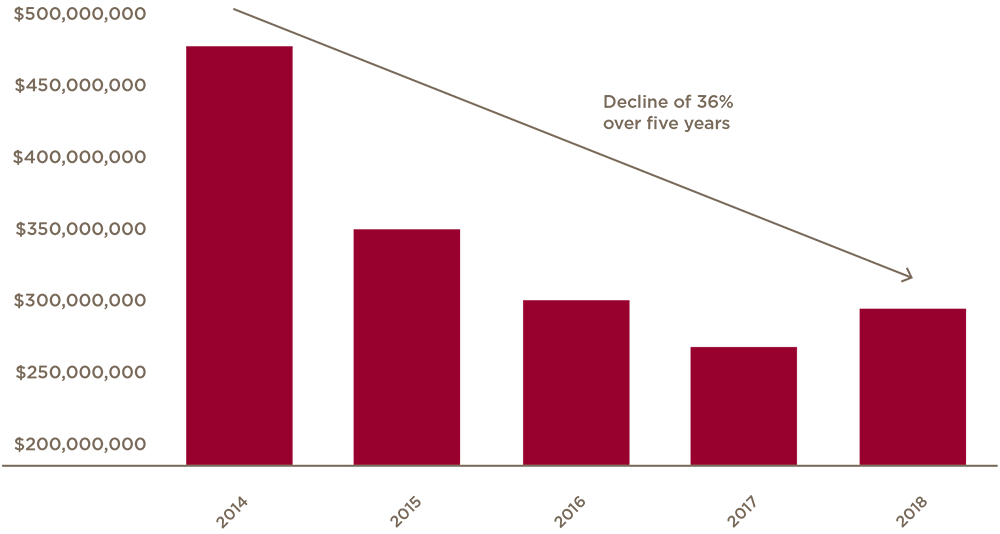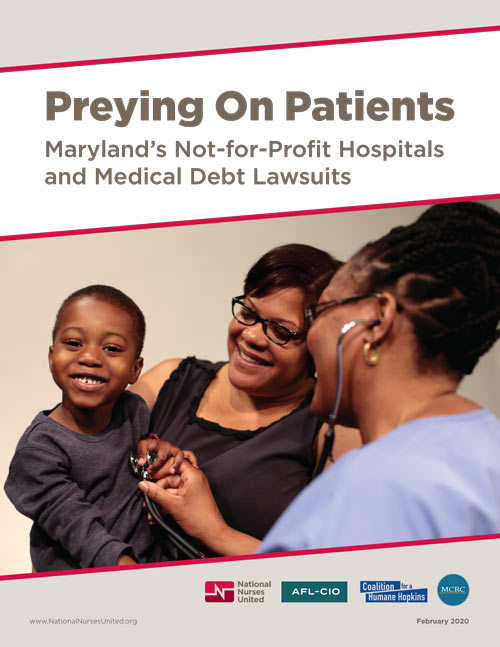Preying on Patients

Maryland's Not-for-Profit Hospitals and Medical Debt Lawsuits
Summary
The argument of this report is simple: There is no economic rationale for Maryland hospitals to sue so many of their patients. The impact of medical debt lawsuits on patients is incredibly damaging and likely deters low-income Marylanders from seeking medical care. The General Assembly must pass legislation to protect patients by better regulating when lawsuits can be pursued as well as increasing hospitals’ obligations to provide financial assistance for care.
Click here to download the full study
Look up data by county or hospital
Between 2009 and 2018, Maryland hospitals filed 145,746 medical debt lawsuits seeking $268,711,620 from patients. In addition, numerous wage garnishments and liens were filed. At least 3,278 lawsuits ended with the patients filing for bankruptcy. No doubt, $268.7 million is a large amount of money, but numbers must be placed into context. During this same time period, Maryland hospitals, all of which are classified as not-for-profits, had operating revenues of almost $147 billion and $5.68 billion in net income. When compared to the hospitals’ operating income and net income, the $268.7 million debt is relatively small. The amount of medical debt sought in lawsuits as a percentage of operating revenues is 0.18 percent and medical debt sought as a percentage of net income is 4.7 percent. These hospitals could easily write off these medical debts with minimal effect on their bottom line.
Overall Medical Debt Lawsuits Filed by Not-for-Profit Hospitals: 2009 – 2018 |
|
| Total Lawsuits | 145,746 |
| Medical Debt Targeted by Lawsuits | $268,711,620 |
| Median Amounts | $944 |
| Total Lawsuits Resulting in Garnishment | 37,370 |
| Medical Debt Targeted by Lawsuits Through Garnishments | $59,551,567 |
| Total Liens | 4,432 |
| Total Medical Debt Targeted by Lawsuits Through Liens | $12,503,871 |
| Medical Debt Lawsuits Ending in Patient Bankruptcy | 3,278 |
In addition, during the last five years, the executives of these hospitals have rewarded themselves handsomely. Some 1,068 executives received $1.66 billion in aggregate compensation. Compensation amounts in excess of $1 million were paid 274 times to 112 individuals. To put the $1.66 billion in executive compensation in perspective, in the last five years Maryland hospitals posted $3.56 billion in net income. Executive compensation as a percentage of net income is 46.6 percent. Compare this to the 4.7 percent medical debt as a percentage of net income above and it becomes clear the amount sought in these lawsuits is a small fraction of hospitals’ net income.
Executive compensation for Maryland not-for-profit hospitals and systems, last five years |
|
| Total Compensation | $1,659,854,574 |
| Number of Annual Payments to Executives | 3,143 |
| Number of Individual Executives | 1,068 |
| Number of annual payments over $1 million | 274 |
| Number of annual payments that put executives above the 1% of income bracket in Maryland | 1,348 |
Finally, in the last five years, the amount of charity provided by Maryland hospitals, both absolutely and relatively, has declined even as hospitals receive charity care rate payer support to offset the cost of providing charity care. These hospitals could easily reclassify the medical debt in these lawsuits to charity care with little to no impact on their financial well-being. Such a move would provide immediate and lasting relief to their patients.
Total Charity Care Provided by Hospitals has Declined 36% in Maryland Since 2014

The fact that tens of thousands of sick and poor residents of Maryland are being victimized through medical debt lawsuits originating from wealthy and heavily subsidized not-for-profit hospitals makes it clear that the state’s policies on charity care and medical debt are not working.
To put an end to abusive and unnecessary medical debt lawsuits, we make two demands of Maryland’s not-for-profit hospitals:
First, all Maryland not-for-profit hospitals must suspend currently open and impending medical debt lawsuits for a period of 18 months to allow time for a review and audit of all policies relating to medical debt, collections, charity care, and contracts with attorneys to collect medical debts, including to file medical debt lawsuits.
Second, Maryland’s not-for-profit hospitals should declare forgiveness for all debt associated with currently outstanding medical debt lawsuits.
To ensure the volume and damage caused by medical debt lawsuits is minimized going forward, we propose the General Assembly enact the following reforms:
- Hospitals must increase who is eligible for free and reduced-cost care under financial assistance policies, including increasing the threshold for free care up to 300 percent of the federal poverty level (FPL), with a sliding scale for patients between 300 percent and 600 percent of FPL.
- Asset protections for patients with medical debt must be increased — including protecting liquid assets up to $20,000, primary residences, and motor vehicles.
- The public and private enforcement of both financial assistance policy requirements and debt collection requirements must be enhanced.
- Medical debt collection practices must be improved by taking the following steps:
- Ban hospitals from placing liens on primary residencies or seeking arrest warrants.
- Ban hospitals from garnishing wages if the patient was eligible for free or reduced care costs.
- Ban medical debt lawsuits for $5,000 or less against all patients and all medical debt lawsuits against those who were uninsured at time of service.
- Require hospitals to offer income-based repayment plans that have reasonable terms that will allow patients to pay off their medical debt
To make our case, this report will provide detailed tables and graphs in sections on medical debt lawsuits, the financial health of hospitals, executive compensation, and the provision of charity care.
